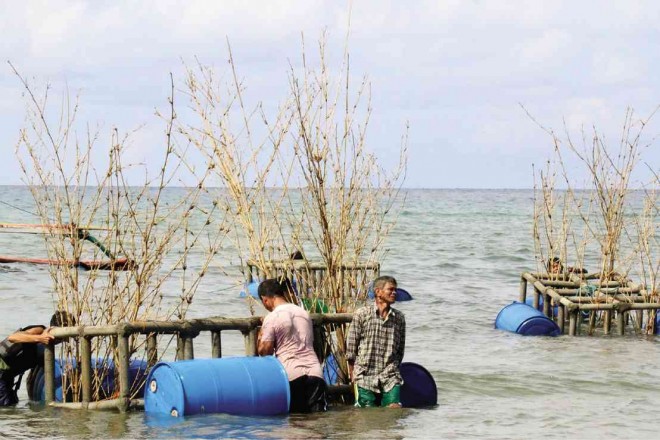
ARTIFICIAL coral reefs ready for deployment in Catanauan town, Quezon province PHOTO COURTESY OF QUEZON PIO
LUCENA CITY—The provincial government, coastal town officials and local fishers have been dropping man-made artificial coral reefs into the seas of Quezon to address the depletion of fish in the province.
Roberto Gajo, provincial agriculturist, said proponents of the artificial reef project had been encouraged by an increase in daily catch by fishermen in towns where artificial reefs had been put in place earlier.
The project, called Adopt-A-Reef, was conceptualized by Governor David Suarez and started in 2011.
Gajo, in a phone interview on Wednesday after the launching of the project in Catanauan town facing Tayabas Bay, said the local fishing industry was back on its feet after long years of overfishing, destructive fishing practices and destruction of mangroves and coral reefs.
He recalled that in Unisan town, which was among the first beneficiaries of the project, fishermen used to have a daily catch of 3 to 10 kilograms.
“Now, most fishers enjoy a daily average catch of 15 to 20 kg,” he said.
Janet Geneblazo-Buelo, Quezon public information officer, said that in 2010, artificial reefs made from concrete, bamboo and other materials were distributed with support from private donors and local fishing organizations.
Gajo said over 300 local fishers from the villages of Ajos, Pala and Madulao in Catanauan vowed to protect the man-made reefs.
“Because they know that they will be the one to benefit from the project,” he said.
The task of monitoring the artificial reefs was turned over to the Municipal Fisheries and Aquatic Resources Management Council.
The agriculture office also distributed four motorized boats for the use of local fish wardens who protect municipal waters from illegal fishers.
Gajo said the project had been launched in the towns of Infanta, Sariaya, Padre Burgos, Unisan, San Francisco, Plaridel, Gumaca and Guinayangan.
Thirty-four of Quezon’s 42 towns are coastal—17 along Lamon Bay in Pacific Ocean; 12 in Tayabas Bay, facing China Sea, and five in Ragay Gulf.